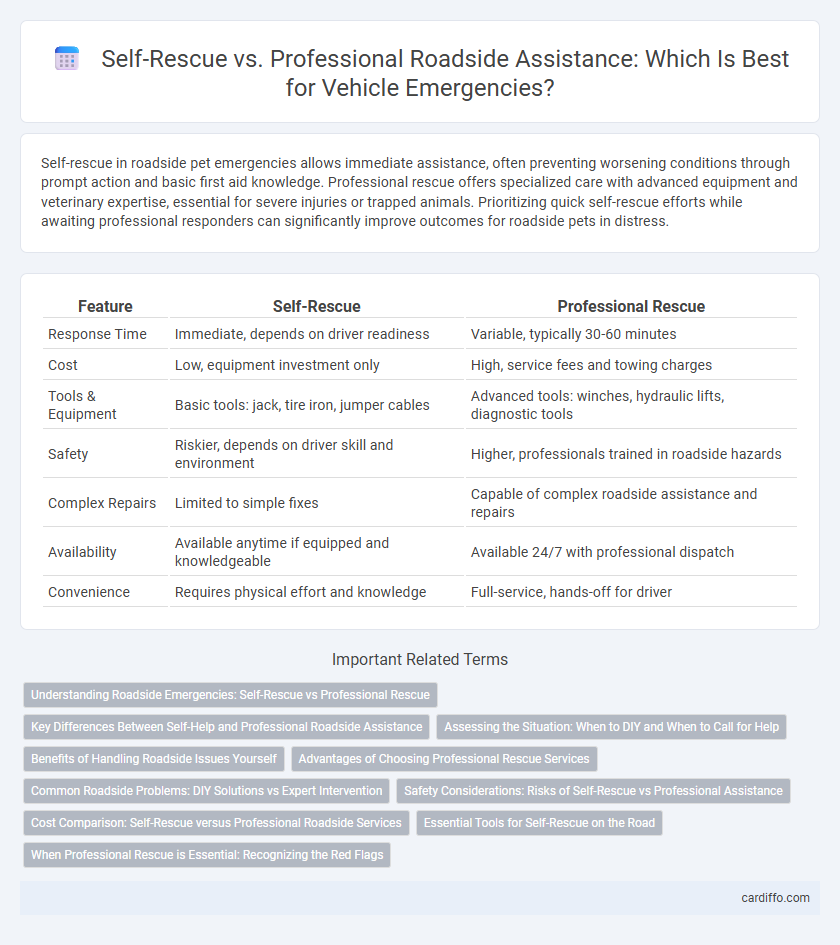Self-rescue in roadside pet emergencies allows immediate assistance, often preventing worsening conditions through prompt action and basic first aid knowledge. Professional rescue offers specialized care with advanced equipment and veterinary expertise, essential for severe injuries or trapped animals. Prioritizing quick self-rescue efforts while awaiting professional responders can significantly improve outcomes for roadside pets in distress.
Table of Comparison
| Feature | Self-Rescue | Professional Rescue |
|---|---|---|
| Response Time | Immediate, depends on driver readiness | Variable, typically 30-60 minutes |
| Cost | Low, equipment investment only | High, service fees and towing charges |
| Tools & Equipment | Basic tools: jack, tire iron, jumper cables | Advanced tools: winches, hydraulic lifts, diagnostic tools |
| Safety | Riskier, depends on driver skill and environment | Higher, professionals trained in roadside hazards |
| Complex Repairs | Limited to simple fixes | Capable of complex roadside assistance and repairs |
| Availability | Available anytime if equipped and knowledgeable | Available 24/7 with professional dispatch |
| Convenience | Requires physical effort and knowledge | Full-service, hands-off for driver |
Understanding Roadside Emergencies: Self-Rescue vs Professional Rescue
Understanding roadside emergencies requires recognizing when to attempt self-rescue versus seeking professional rescue to ensure safety and efficiency. Self-rescue techniques, such as changing a tire or jump-starting a battery, are suitable for minor issues with appropriate tools and knowledge at hand. Complex situations involving severe accidents, medical emergencies, or hazardous conditions demand immediate professional rescue to prevent further harm.
Key Differences Between Self-Help and Professional Roadside Assistance
Self-rescue on the roadside involves using personal tools and knowledge to address common vehicle issues like tire changes or jump starts, offering immediate but limited relief. Professional roadside assistance provides specialized equipment and expert technicians capable of handling complex problems such as engine failures or heavy towing. Key differences lie in response time, scope of services, and reliability, with professionals typically ensuring safer and more comprehensive solutions.
Assessing the Situation: When to DIY and When to Call for Help
Assessing the situation on the roadside is crucial for deciding between self-rescue and professional rescue. Minor issues such as changing a flat tire or jump-starting a battery can often be resolved safely with basic tools and knowledge, minimizing delay and cost. However, situations involving severe damage, uncertain hazards, or personal injury require immediate professional assistance to ensure safety and proper vehicle handling.
Benefits of Handling Roadside Issues Yourself
Handling roadside issues yourself offers immediate assistance, reducing wait time for professional help and minimizing potential risks of being stranded in unsafe locations. Self-rescue empowers drivers to address common problems such as flat tires, dead batteries, or minor engine troubles, enhancing confidence and vehicle knowledge. This proactive approach can save money on towing and labor costs while maintaining control over the situation.
Advantages of Choosing Professional Rescue Services
Professional rescue services offer advanced equipment and trained personnel capable of handling complex roadside emergencies efficiently, ensuring swift and safe vehicle recovery. These experts provide comprehensive solutions, including towing, mechanical repairs, and accident management, which reduce the risk of further damage or injury. Relying on professional rescue increases reliability and peace of mind, as these services are available 24/7 and adhere to safety regulations.
Common Roadside Problems: DIY Solutions vs Expert Intervention
Common roadside problems such as flat tires, dead batteries, and minor engine issues often have effective DIY solutions like tire changes, jump-starts, and basic troubleshooting. However, complex situations involving severe mechanical failures, accident damage, or hazardous conditions require professional rescue services equipped with specialized tools and expertise. Prioritizing expert intervention in critical scenarios ensures safety, prevents further vehicle damage, and facilitates timely road clearance.
Safety Considerations: Risks of Self-Rescue vs Professional Assistance
Self-rescue on the roadside involves risks such as exposure to traffic hazards, lack of proper tools, and potential for injury due to inexperience. Professional rescue teams utilize specialized equipment and training to secure the scene, ensuring both vehicle occupants and responders remain safe. Prioritizing professional assistance reduces accidents, enhances timely medical aid, and minimizes further damage or injury during roadside emergencies.
Cost Comparison: Self-Rescue versus Professional Roadside Services
Self-rescue costs primarily involve purchases of basic tools and supplies, generally under $100, while professional roadside services, such as towing and lockout assistance, average $75 to $150 per incident. Repeated reliance on professional services can escalate expenses significantly compared to one-time self-rescue investments. Evaluating frequency of breakdowns and skill level helps determine the most cost-effective option for roadside emergencies.
Essential Tools for Self-Rescue on the Road
Essential tools for self-rescue on the road include a reliable jack, lug wrench, jumper cables, and a tire pressure gauge to handle common roadside emergencies independently. A high-quality flashlight, reflective warning triangles, and a multi-tool enhance safety and versatility during unexpected breakdowns. Emergency supplies such as a portable air compressor, first aid kit, and waterproof gloves further strengthen readiness for self-rescue situations.
When Professional Rescue is Essential: Recognizing the Red Flags
Professional rescue becomes essential when roadside incidents involve severe vehicle damage, injury, or hazardous conditions such as fuel leaks or unstable terrain. Red flags include inability to safely extricate yourself, lack of proper tools or expertise, and worsening weather conditions that increase risk. Prioritizing professional assistance ensures effective, safe resolution and prevents escalation of emergencies.
Self-Rescue vs Professional Rescue Infographic

 cardiffo.com
cardiffo.com